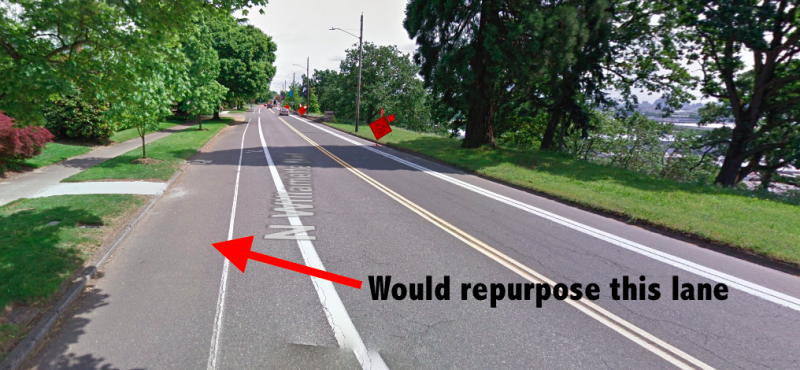
(Image: Friends of Willamette Blvd)
Volunteers from several north Portland neighborhoods are seizing on a paving project as an opportunity for the City of Portland to make long-awaited changes to Willamette Blvd that would improve bicycle access on a key link in the network.
The Friends of Willamette Blvd have set up a website and are urging people to call Mayor Ted Wheeler, City Commissioner Dan Saltzman, and PBOT Director Leah Treat. They also have an online petition to gather as many signatures as they can by the end of this week.
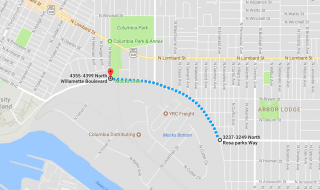
University Park neighborhood resident Robert Ping is one of the group’s leaders. He’s been working for two years now with an ad hoc committee that includes representatives from several north Portland neighborhoods and the University of Portland (a small college whose campus is on Willamette). The group has presented their idea at many neighborhood association meetings during that time. They’ve also run the idea by PBOT and have been in touch with Commissioner Saltzman’s office. “So far all the feedback we’ve gotten has been positive,” Ping shared in an an interview today.
Ping says he’s lived in the neighborhood for 14 years, rides Willamette twice per day on average, and he wants it to be safer.
Willamette Blvd currently has unprotected bike lanes and one standard vehicle lane in each direction. It also has an extra lane currently used as free parking for adjacent residents (nearly all of whom also have large driveways and/or parking spaces available on sidestreets). The Friends of Willamette Blvd want the city to repurpose that northern curbside lane for mobility purposes instead of free parking, which would create the space needed to restripe the street with wider and buffered bike lanes in both directions, and a five-foot wide shoulder on the bluff side for people who want to walk or run with a view of Swan Island and the downtown skyline.
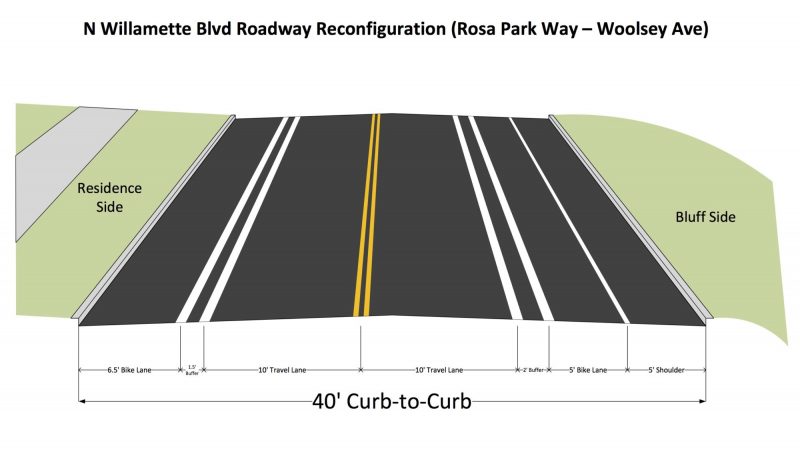
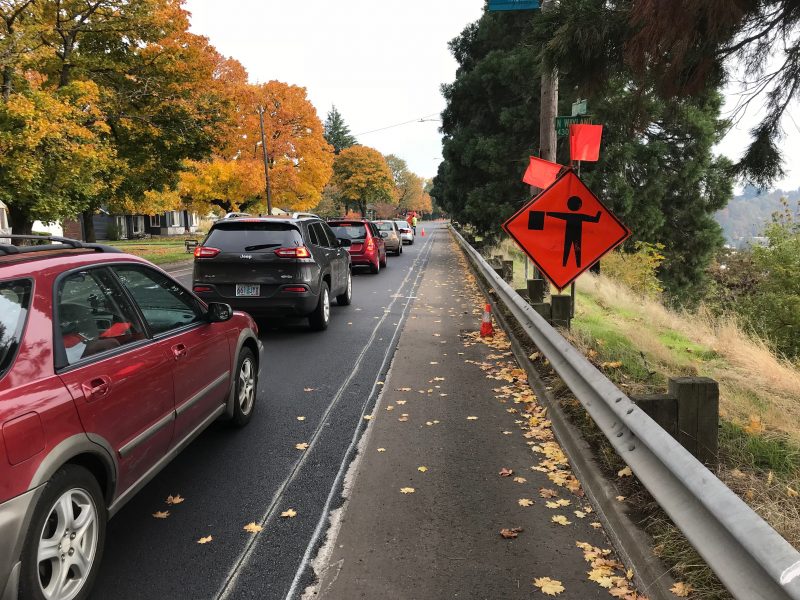
(Photo: Robert Ping)
“Given the low utilization of existing on‐street parking and availability of alternative parking opportunities on nearby cross streets, private driveways, and garages, there may be opportunities to prohibit on‐street parking in order to pursue innovative bicycle treatments on Willamette Boulevard.”
— PBOT in 2011
Willamette has long been on the radar of PBOT as a street in need of better bicycle access. In 2011 PBOT undertook the North Willamette Boulevard Bikeway Development Project. Their plans were also to create more space for cycling by reallocating space currently used to park cars. But before the project even got started, PBOT accepted defeat because homeowners didn’t want to give up their parking spots the space they use to park cars in the street. As we reported at the time, The Oregonian called PBOT’s retreat, “a troubling statement about where Portland’s 2030 Bike Plan is headed without better work from the folks at the top.”
PBOT promised to look at “other options” but the project was shelved and not much has happened since. Thankfully PBOT hasn’t completely forgotten about Willamette. In recent years the bikeway has been widened and an extra stripe added to the southbound bike lane. The speed limit has also been recently reduced from 35 to 30 miles per hour (which is still very dangerous when drivers put their cars just inches from vulnerable road users).
But it’s not enough. As Portland has grown, auto use has gone up and many drivers use Willamette as a cut-through to avoid Lombard (this is epidemic happening on dozens of Portland streets right now, but that’s a different post).
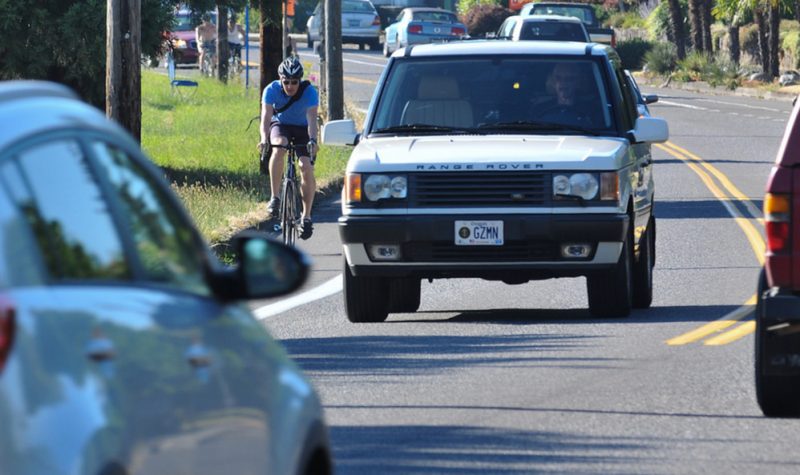
(Photo: J. Maus/BikePortland)
Advertisement
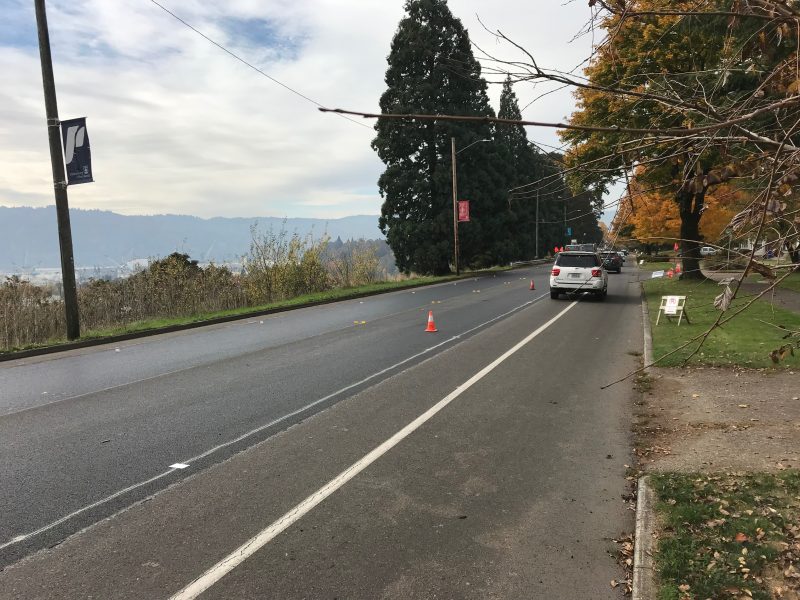
The current paving project came up rather abruptly, with sources telling us that PBOT and their maintenance division weren’t as coordinated as they should have been. With several bad potholes forming since winter, conditions on Willamette have worsened. People in cars and on bikes swerve to miss the holes and debris, which leads to extremely unsafe situations.
“Every house along Willamette from Bryant to Woolsey has 100 feet of frontage on Willamette and they have a driveway. They literally have four times what any other average home has for parking and they still complain about losing less than half of it.”
— Robert Ping, Cathedral Park neighborhood resident
The Friends of Willamette Blvd think now is the time to make it better and are asking people who live, work, or ride on Willamette to sign their letter. Here’s the text:
To Commissioner Saltzman and Leah Treat
The Friends of Willamette Blvd is a group of residents and business owners in the University Park, Overlook and St Johns neighborhoods who believe that N Willamette Blvd must safely serve people who walk, bike, and take transit. N Willamette is a crucial link in the transportation network for people in our neighborhoods. It is the only connecting street from N Rosa Parks to N Woolsey other than N Lombard (Oregon State Highway 30). For years, members of our community have asked the city to make N Willamette Blvd safe and accessible for people who walk, bike, and take transit.
Currently N Willamette Blvd fails to provide people with transportation facilities they can use safely and comfortably. People accessing transit have no place to wait for westbound buses. People walking on the south side of N Willamette are forced to pick their way along a make shift deer trail with a steep ravine to one side. People bicycling do so next to speeding traffic in narrow bike lanes. As such a vital connection for active transportation, N Willamette must be improved for the city to meet is transportation, livability, and climate goals.
Fortunately, the city has an immediate opportunity to improve the street for people who walk, take transit, and bicycle. The Portland Bureau of Transportation is paving N Willamette Blvd between Rosa Parks and Woolsey. Now is the time to re-purpose the low-use on-street parking to improve safety, comfort, and access for people traveling actively.
We ask that Commissioner Saltzman and Leah Treat direct PBOT to make N WIllamette Blvd a street where all transportation users have safe facilities and access to where they need to go. The opportunity to act is now and the failure to do so means a city that is less safe and less healthy.
Ping says the only pushback to the idea are likely to be the same people complained about parking loss when PBOT last approached them six years ago. To Ping, there’s simply no justification for using limited roadway space in this relatively small section of Willamette for free private auto parking. “Between Rosa Parks and Woolsey, I often see only two or three cars [near a church, which also has an off-street lot]. Every house along Willamette from Bryant to Woolsey has 100 feet of frontage on Willamette and they have a driveway. They literally have four times what any other average home has for parking and they still complain about losing less than half of it.”
Back in 2011, some local residents started an online petition opposing PBOT’s plans. They said the project would take away “100 much needed parking spaces” (PBOT analysis disagrees) and would turn Willamette into “a constant thoroughfare” that, “will decrease the quality of living for existing residents while simultaneously creating a more dangerous N. Willamette Blvd. for all stakeholders.” 15 people signed that petition.
The Friends of Willamette Blvd’s petition has about 60 names so far.
Asked whether PBOT will consider new striping with their current paving project, spokesman John Brady told us this morning that, “Yes, we will review the striping and look for ways to improve it.” When they last looked at the issue in 2011, PBOT’s plan was to shift auto traffic to the south and stripe a two-way bikeway on the north side.
What the striping ultimately looks like, and whether or not PBOT will use the full width of the street to create safer access for vulnerable road users — or if they’ll continue to protect free parking for a few dozen homeowners — remains to seen.
— Jonathan Maus: (503) 706-8804, @jonathan_maus on Twitter and jonathan@bikeportland.org
Never miss a story. Sign-up for the daily BP Headlines email.
BikePortland needs your support.


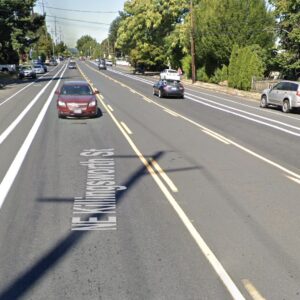
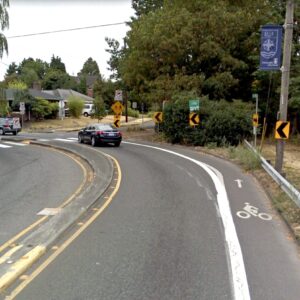

Thanks for reading.
BikePortland has served this community with independent community journalism since 2005. We rely on subscriptions from readers like you to survive. Your financial support is vital in keeping this valuable resource alive and well.
Please subscribe today to strengthen and expand our work.
I totally support this, but isn’t it way too late? The project is already halfway done.
Hi Sara. Still plenty of time. They’ve only done the paving, so there’s a clean slate of roadway. Next step is for PBOT to decide how the lane striping should be done. Keep in mind that the changes this group wants would cost PBOT nothing.
Well, it would be wonderful. My 6 year old is ready to ride longer distances, but it’s feel so unsafe to have her ride on Willamette that we rarely do it. I’d love a safer option.
First they took away free parking, but I didn’t care because I had a 3 car garage.
then they took away a motor lane for bikes, but I didn’t care because I didn’t drive on that street
then they widen the sidewalks close to school but I didn’t care because my Nanny liked walk the kids to school
then they added congestion pricing, but I didn’t care because traffic jams ended
then they increased the gas tax by 1,0000%, but I didn’t care because I drive a Tesla and Prius
Finally, when they forced me into a twizzy ( video below ) , there was no one left to care; everyone was walking or cycling around town
https://www.youtube.com/watch?v=Zhi0b70tO-g&list=PLzNM_rzDSme6P4gvpkVIVGEo1ta2TFMeS&index=48
Thank you Jonathan! My family cycles this section daily and this would be a wonderful, “free” improvement. I’d strongly prefer a 2-way lane on the North side of the street to eliminate the difficult left turn from the side streets onto Willamette, but I’ll gladly sign the petition (and spread the word) for this incremental improvement.
Oh such a difficult decision. Providing free storage space for private property or making the public streets less dangerous. Hmm, add in a sprinkling of climate change and it’s clear we must stay with the status quo, otherwise someone might confuse Portland with a city that isn’t clueless.
Seriously, how is this even an issue? Doesn’t PDX have one of those cute little priority pyramids that place pedestrians and cyclists above all? How can car storage even begin to trump them both?
Buffered lanes are nice, but this stretch is crying out for fully protected lanes, especially southbound where there are zero driveway crossings. I know a single row of plastic bollards won’t work on the inside of a curve (which is why Minneapolis isn’t using them on curving sections of protected bikeway, something Portland should needs to get a clue about), but that just means we need to put in something more substantial.
Seattle uses 6″ high by 6-12″ wide concrete curbs as medians and even to separate left turn lanes from straight-through traffic. Seems like a good application for something similar. Wouldn’t have to be continuous, either.
Lame for the ridge edge. This corridor is the Terwilliger Parkway of North Portland and it needs a lower speed limit.
It did just get lowered to 30mph from 35mph.
Please join us in making a better Willamette Boulevard for many, many, more Portlanders. Click the “join us” link on the website and also write PBOT Director Leah Treat and Commisioner Dan Saltzman.
GlowBoy (and others) you make a good point about what is possible along the bluff. The effort this week is to take advantage of the paving project which is already underway, with hopes that in the near future we can get even better improvements along Willamette Blvd. Some of our ideas include curb-protected bike lanes or a two-way protected bike lane on the bluff side, pedestrian crossing islands, a multi-use path on the bluff side, covered bus shelters especially on the exposed bluff side, reduced turning radius onto side streets, and more. All this takes money, so there is more work to be done. The paving project is already happening, and changing the striping costs nothing extra!
And residents on Willamette Blvd will benefit greatly with a calmer, safer, more pleasant streetscape in front of their homes!
Hi Robert, I’m the Chair of the Cathedral Park Neighborhood Association. We are already advocating for improvements along Willamette. Let’s get together. Jennifer
Hi Jennifer, nice to meet you! We would love to share notes and ideas! Don’t want to give out my info here, but if you can contact Scott B. in St. Johns he has my contact info. Or go to: scenicbluffpdx.weebly.com and use the ‘contact us’ tab.
I’d be concerned about the transition points, unless they restriped from Rosa Parks to at least Portsmouth and preferable to Richmond, would this only really improve Willamette significantly. The current areas without any bike lanes (Ida to Richmond) should be the priority. I get the feeling without Tri Met “approval” this will never come to fruition.
If adjustments require additional dollars, I’d rather see them spent on the St. Johns end where there aren’t any bike lanes at all. The segment they are paving is by far the less stressful of the two ends.
I get this, but the immediate options are fewer past UP toward STJ. Granted all free public parking could be pulled (please) –and I believe UP should provide more student and event parking– but you can’t just do this overnight.
They could create the NP Greenway trail that would run along the base of the bluff around UP all the way to Cathedral Park. The connection to Willamette could be from the Waud Bluff Trail- where the trail currently switches back, it could extend all the way down to the river.
Hi! The stretch from N Ida to N Richmond is located in the Cathedral Park Neighborhood, not in St. Johns. We just became aware of this advocacy and this thread. Please get in touch with the Cathedral Park Neighborhood Association. We want to be involved.
This is a great idea. It would go a long way in making that road feel and be much safer. I’m scared to ride with my daughter on this street because of the volume and speed of cars.
And of course, after this, how’s about extending the Willamette bike lane all the way to St Johns!
More people commuting via bike on Willamette. But more people are also commuting via car on Willamette. With more cars we’re seeing more impatient hurry-up brake tailgating behavior from drivers, more drivers floating out of car lane around corners, more high speeds turns onto side streets, and greater difficulty for cyclists to pass slower riders in the near bumper-to-bumper spacing. Tensions and stress are running too high.
They just (thankfully) reduced the speed limit on Willamette Blvd from 35 down to 30 mph. Hopefully they will enforce it.
30 is still too fast when you have cars traveling at less than half a car length. No room for errors; it’s either bumper or bike lane.
There is also a steady stream of FedEx and UPS trucks heading back to swan island that use willamette in the afternoon. Professional drivers are pretty good, but they use wide vehicles with big mirrors, and their drivers offer cyclists no quarter, in terms of slowing or inching to the center to give some room.
I’ve seen this kind of partial paving in several places around town. It’s actually a great argument when you encounter people that complain about cyclists “not paying their fair share”. This is hard, physical proof that cars cause roadway damage, and bicycles do not.
You only address part of the argument. Another part is where the money comes from for making these changes for bicycles. Why not implement a fee based bicycle registration as with automobiles? Shouldn’t cyclists shoulder their share of the costs? I’m not referring to damage but the installation of all that makes biking possible. What about liability insurance at a minimum of coverage? It’s not as if all accidents are caused by autos.
From property taxes, which are paid by all. The gas tax only funds a portion of local road spending, and primarily goes into paving projects like this. The vast majority of bike infrastructure in the city is just paint on the road, and the bike lanes usually double as a breakdown shoulder, space for busses to pull over, loading/unloading zones, etc. Cyclists are not being given valuable road space. We are given table scraps.
Property taxes are paid by property owners. I think the biking infrastructure involves more than laying paint but even that has costs. I just think that requiring cyclists to contribute to the costs by way of a registration system along with mandatory liability insurance is one way to address a couple of issues. I also feel this would improve the relationships between non-bikers of Portland and the bikers at a minimum expense. It reflects a shift in attitude. Instead of “I deserve this because I’m here” to “how can we make this safe and workable and fair for all”.
Most cyclists are property owners. Landlords pass these taxes on to their renters, so cyclists that rent pay taxes as well. If your complaint is about homeless cyclists, I guess you have a point. Maybe we need a homeless cyclist tax?
Once cyclists start causing measurable amounts of personal injury and property damage in our city, we can talk about registration and personal liability insurance. Motor vehicles are involved in 100% of the fatalities on our roads, and the operators are at fault in most cases.
Your attitude just makes it harder for fair minded cyclists who are actually looking for solutions. My hope is that you remain the minority you seem to want to be. Let others, who are better equipped handle the heavy lifting.
You are looking at a solution for a problem that doesn’t exist. I suggest you research the numbers. Look at actual data, and stop responding to this emotionally. The data is very clear:
– Bike registration never works.
– Cyclists help city road budgets.
– Subsidizing cycling is good public policy.
https://chi.streetsblog.org/2013/10/24/no-a-bike-license-fee-doesnt-make-any-sense/
https://www.fastcompany.com/3021074/making-the-economic-case-for-cycling-friendly-cities-with-bikeonomics
https://momentummag.com/free-rider-myth/
I wasn’t complaining but offering a different perspective. You clearly read more into what I posted than was said or meant by me. Then further added an issue not related to anything being discussed.
Who are you to decide when we can talk about cycle registration and insurance? Am I looking for a solution to a problem that doesn’t exist? What I see as a problem is the animosity between cyclists and property owners with neither side willing to budge. What I see as one possible solution is a simple shift of attitude. Each side give a little. A signal of cooperation.
I’m not responding emotionally, despite your assertion…but you are. I don’t have a dog in this fight. I can’t ride. I respect cyclists and give them their right of way, I’m always on the look out for them, never casually swing open a car door, I am greatful to them for fewer cars on the road. I am not a property owner either. I live in section 8 housing but not for much longer as I’m terminal so my contribution to the system is small. All I offer is my thoughts. Our city is having growing pains and I’m familiar with pain. Not all pain is bad. Sometimes it’s a nudge in a new direction, a cue to take a deep breath and consider options thoughtfully and careingly. This is not a war but challenges and rewards.
I am sorry if I have offended you. I had chemo yesterday and let’s just say it plays with my head at times.✌
Additionally I recommend the book The Wisdom Of Crowds.
“property taxes are paid by property owners”
Property taxes are paid by everyone who lives indoors and/or purchases goods and services in this city.
“You only address part of the argument. Another part is where the money comes from for making these changes for bicycles. Why not implement a fee based bicycle registration as with automobiles? Shouldn’t cyclists shoulder their share of the costs? I’m not referring to damage but the installation of all that makes biking possible. What about liability insurance at a minimum of coverage? It’s not as if all accidents are caused by autos.”
This is a very nuanced issue—or not, depending on how you think about it. “All that makes biking possible” are roads. Unstriped roads would be plenty—the same ones that you drive on. Bike lanes are not necessary to make biking “possible”. “Protected” infrastructure is not necessary to make biking “possible”. All we need are plain, vanilla roads. Now, inattentive drivers who want to go very fast in motorized vehicles tend to make biking more dangerous, similar to how smoking makes the air around the smoker more unhealthy. Should we continue to allow smoking in public buildings but charge non-smokers for respirators? The special infrastructure you consider to be necessary for biking isn’t necessary for biking; it is only necessary because drivers can’t be counted on to mitigate the danger they pose to everyone around them by driving cautiously and responsibly. This is partly due to our individualistic values here in the U.S., which tend to put the onus of “safety” on those who would be harmed, rather than those who are causing the harm. We sub-consciously think of drivers like wild bears and traffic as a hurricane—things that just can’t be tamed or stopped—and so we imagine that storm cellars and cages, in the form of elaborate, “protected” “bike” infrastructure are the answer to keep the bears away and prevent storm damage. In reality, we are the bears, and the storm is of our own making; it could be undone, we just refuse.
Conversely, extra-wide streets are necessary to make street parking possible, and parking renders part of the road that could be used for travel unusable. One person parking a car on the street prevents hundreds from traveling down that portion of the roadway. Shouldn’t we charge people who want to store their private vehicles in public space? Or do you imagine property/gas/other taxes you also imagine are solely paid by people who never ride a bike cover things like free street parking in neighborhoods? I’d have to check the law, but I don’t believe ownership of a piece of property extends into the street. It sure is convenient to have part of the public way donated to residents for storing vehicles, but it is by no means a right or entitlement.
Regarding liability insurance, let me present a couple of scenarios: Let’s pretend I’m flying down the street on my bike, going, I don’t know, 30 mph. Now let’s say I fail to negotiate a turn, hit a curb, and go tumbling into someone’s front yard. What sort of property damage do you suppose would result? Now imagine I’m driving my SUV at the same speed, and the same thing happens. How much damage now? This actually happened across the street from my house years ago, and I can tell you just how much damage happens. A lady in a Pathfinder went straight at a point where the road curves. She plowed over a boulder, gouging up my neighbor’s front lawn, kept going until she knocked over his front walkway lamp, bounced off the corner of his garage, damaging the house, careened down his driveway and over a utility box, damaging city property, and probably totaled her SUV. So, that’s one reason why motor vehicles require insurance and bicycles don’t.
Now, let’s imagine a driver is innocently driving down the road on a dark, rainy night, only going 5 mph over the speed limit, as is our custom here, when out of nowhere, a bicyclist darts into the street (wearing all black of course) and gets hit by the car. How much damage would be done to the car? Did I mention that this bicyclist was walking across the road? Oh, and did I further mention that this bicyclist had actually left their bike at home that day? Would the amount of damage really be any different? Should we then require pedestrians, who seem to get hit a lot more than bicyclists around here, to carry liability insurance for walking?
I can understand the emotional appeal of making these arguments for “fairness”, but really, this is a problem and a “need” caused nearly completely by motorists. To call for people—who in all likelihood are part-time motorists themselves—to pay extra for using less, costing society less, and assuming a good deal more risk in the process, is tantamount to extortion, not “fairness”.
Another part is where the money comes from for making these changes for bicycles.
http://www.vtpi.org/whoserd.pdf
http://grist.org/article/2010-09-27-why-an-additional-road-tax-for-bicyclists-would-be-unfair/
And about a zillion other sources.
I ride Willamette Blvd every day to and from work. The parking lane is always much less than 10% utilized. People who say they need the parking there are plainly lying.
And since it is already a thoroughfare, changing the striping won’t make it become one.
I would like to see Willamette converted to one-way northwest bound between Rosa Parks and Portsmouth- they could keep on-street parking or not. The bluff side (south/west half) of the street could be converted into a fully separated, 2-way multi-use path. A few overlooks/benches could be created along the bluff. At the swithcbck, the Waud Bluff trail could be extended to the river to create the portion of the NP Greenway that runs at the base of the bluff beneath U of P. An off-street trail on the west side of Greeley could run under Going at the base of the bluff, gradually climbing up to Willamette to join at Curtis. To me, this seems like the most pleasant, recreational, functional, beautiful, and best connected option for the NP Greenway trail. A separate trail could and should made across Swan Island (and the Waud Bluff Bridge OBVIOUSLY needs its stairs replaced with a ramp!). If we are going to push PBOT to something meaningful, lets think a little bigger! If we let the neighbors keep their parking, they might even join us.
In past Vancouver projects I have worked on to replace on-street vehicle storage lanes with bike lanes, one of the unintended – thus secondary outcomes – the resulting overall effect has been to make the homes “curb-appeal” much prettier for passing traffic. And this would even be more dramatic for this project since many of the homes along the bluff are very architecturally striking vs the Vancouver corridors. Additionally, the residents of these homes would likely have a much improved view of the river area and west hills without anyone’s cars parked in front of the homes.
If we relocate enough Zombie RVs to this area, perhaps the neighbors will change their minds about parking preservation?
Documentation of this needs to be shared with the residents on the bluff. They believe the ‘alternative facts’ that the opposite is true.
I was referring to Mr. Boulanger’s “curb appeal” / increased home value comment.
Has anyone taken video / photo documentation at how under utilized these parking lanes are during “peak” visitor periods – say Xmas and Thanksgiving?
It’s only a couple of weeks away, Todd… we shall see how the timeline develops with this.
In 2010 I commuted from St. Johns to Albina & Killingsworth. I don’t understand the appeal of two-way bike paths on one side of the street, because they always end somewhere, and crossing from the bike lane over to right side of the street is a pain. My experience is with the lane on SE 30th & Stark, which I use regularly. The only reason it works is the relatively light traffic on 30th, which can’t last.
what if the entire bluff half of the street from Rosa Parks to UP was a shared bike/walking multi-use path? What if Willamette was one way and a lane of parking heading north/northwest? On the northern end, the new path would connect to the NP Greenway down the Waud Bluff trail and continue around the base of the bluff around UP to Cathedral Park! At the southern end, the off-street trail would head down the bluff at an angle from Curtis or so down to the bottom of the bluff where it would travel under Going, then continue between Going and the RR tracks, but off-street, up to Russell. Then you would use the signal to continue on the bike lanes along Interstate. Eventually, an “espalande” treatment will need to connect a river path from the Broadway Bridge to Swan Island.
all I can see in those photos are the temporary traffic control signs placed right in the middle of the bike lane…
Plus, maintenance crews just turn up randomly in your fave bike lane and close it down for paving w no advance notice and no alternate route marked.
This conversion of public right of way to public use is LONG overdue. Bravo! to the neighborhood activists. With this Bluff side path, one will be able to walk, run or ride from U of P to Adidas (and back) without crossing a single street. Let’s get it done!
Right on, Lenny!
I’d like to point out the reason why removing street parking here to make better bike/ped facilities can work is because there is off-street parking . . . Something to think about when we approve no-parking development.
Willamette is fine as it is. I ride that street on my bike and it is fine. People need to learn how to ride in traffic. I’ve ridden my bike in Portland since I was 5 years old — learn how to ride like an adult, not like a scared little kid. The bike lanes on Willamette are just fine, stop your whining. Why don’t we spend our limited road dollars on paving streets in outer Portland. You people want to make Willamette one-way or car-free — that is nuts. The cars will just go to side streets.
I disagree. I’ve been riding here for a long time and Willamette is quite unpleasant.
And I’d appreciate if you didn’t tell me that I’m a “scared little kid.”
Have you ever ridden in the eastbound bike lane when it’s heavy with debris, while pulling a burley trailer with a toddler in it? You are forced to hug the left side of the lane. It is not super pleasant, and I’m a pretty fearless rider. So maybe consider that your experience is not the only experience.
Free storage for private motor vehicles in the public right of way is absurd 1950’s style thinking.
The way they are currently repaving Willamette – just the car travel lanes and not the whole street, curb to curb, and not the bike lanes, makes a bit of sense in this section, since the car lanes were in really bad shape in spots. But, they did the same treatment on upper Willamette, North of Portsmouth, about 6-7 years ago, resurfacing the center section of the street, but not the bike lanes. In that stretch of road, there are many utility cuts that were made in the bike lanes, as folks have chopped into the pavement to access sewer, water, and gas lines over the years. This leaves the bike lane in terrible shape, with many poorly made patches, cracks, bumps, and failed pavement. Meanwhile, the car lanes get a nice new section of blacktop. This does not seem like an equitable practice. I’m sure in a few more years, the bike lanes on Willamette along the bluff stretch will be in poor shape, also, but the chance of a re-surface in the bike lanes will have evaporated with this current project.
The part of Willamette in desperate need of better bike lanes is further north, between McKenna and Carey streets; and then also bike lanes totally disappear from Willamette north of the cut, north of Ida street. There a few terrible spots where the road curves in a dog-leg, and the bike lanes get squeezed down too narrow, and a few storm drains are thrown into the mix to make it really tight – 3 foot lanes. As cars zip through these curves, they cut the corners and drop a tire into the bike lanes, way too tight. And, the missing 1 mile of bike lane out to St John’s is terrible.
“But before the project even got started, PBOT accepted defeat because homeowners didn’t want to give up THEIR PARKING SPOTS.”
I think you mean, “homeowners objected to on-street parking removal.” We should eradicate the notion that this is somehow “their” parking.
Also: these should be called “bluffered bike lanes.” Hey-o!
Oh that was a big mistake on my part Carl. I am constantly working to alter my brainwaves for this type of thing but it appears I haven’t quite finished the process on this one yet. Thanks for flagging it. I have edited that line.
Hope all is well in Boston.
It’s a tribute to you, Jonathan, that I even brought it up. I know you’re someone who’d recognize the distinction and see its importance.
Journalists in Boston? Let’s just say there’s lots of work to do out here.
“BLUFFered Bike Lanes!” Ha Ha Ha Ha! Nice one, Carl. 🙂
Three points.
First: You’re suggesting more bike space, not driving lanes. Bike travel isn’t the problem on Willamette; it’s driving down that road that’s hell. I’ve done both, and currently I’d rather bike down that road than drive it.
Second: If you buy a house in an area with on-street parking, you wouldn’t object to the city deciding you’re no longer allowed to park in front of your own house? Say you’ve lived there for twenty years, and the city decides to go against your wishes to do so. You wouldn’t be angry about that?
Third: Where do you think the cars that are already parked there are going to go? Into driveways? Please. They’re going to be on the side streets, where parking is already hellacious. All this will do is make parking worse and do nothing to realistically make biking conditions worse.
I do think that people who own cars & driveways should put their cars in their driveways. I own a car and it stays in the driveway. I can’t see why this is hard.
You don’t own the space in front of your house. We all own it.
People living on Willamette would prefer to have a 4-lane de facto highway in front of their homes? I doubt it.
Also, remember this: the people on the bluff are living in houses worth well over half a million dollars. They, and people like them, are the ones providing the lion’s share of taxes for bike lanes in the city. Maybe you should take their opinion into consideration.
Hi Samuel,
First: I and hundreds of others (so far) disagree with you that biking isn’t a problem on Willamette. Remember, this isn’t just about how it feels for your or me — it’s about how it feels to a child or to an older person or to an inexperienced rider.
Second: When you buy a house, you buy a house and some land. You do not buy the street. It’s called “PUBLIC” right of way for a reason. And yes, I would be miffed a bit about not being able to park in front of my house — but as an adult who chose to live in a big city I would weigh the cost-benefit and I would consider how my personal feelings might not matter as much as the greater good of the greater public who has equal rights to that space as I do.
Third: Where people end up parking their cars isn’t a big concern of mine. Those houses have huge driveways. And side streets are a fine place to park them if that doesn’t work out. People can also pay for storage units if they have RVs or cars they don’t use. Or they can sell their cars if there’s nowhere to put them.
As for your comment about taxes. That’s just silly. “The people on the bluff”? Why do you think you and others who live there should have special privileges over the public right-of-way in front of your houses? Do you think you deserve more influence in transportation policy decisions because you have a certain level of wealth? We all pay taxes and they are not earmarked for certain projects. And I could care less how much your house is worth. Why do you assume that bicycle users don’t have houses that are more expensive than yours? And again, that doesn’t even matter! Because that’s now how our city works.
Happy to hear other concerns you or other neighbors might have about this project. Please don’t hesistate to ask me questions or share your ideas for better solutions to the problem.
Ladd’s Addition representing, high taxes and all. I’ve never been able to park a car in front of my house. And I’m all for more bikes and bike lanes. So I hope you’ll take my opinion into consideration.
Every curb cut takes a public parking space away! Fight the curb cut.
Oh yes – let NIMBYism control everything…that’s a great way to deal with public spaces. As someone who lives in the neighborhood, I have no sympathy for you – and after reading your opinion, my sympathy decreased even more-so. I don’t feel bad about entitled folks crying about losing something they thought was “theirs”, when it never was in the first place. If you have so much money, then you can afford the land to park your cars on.
What a bunch of gimmes. Willamette blvd already has a wonderful bike lane, and relatively slow traffic. If it ain’t broke don’t fix it.